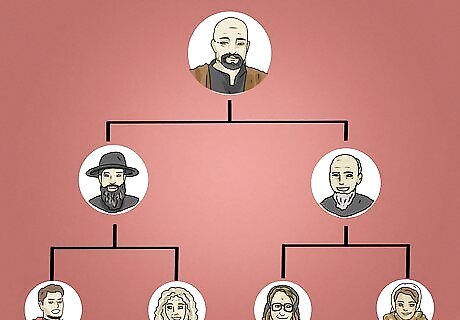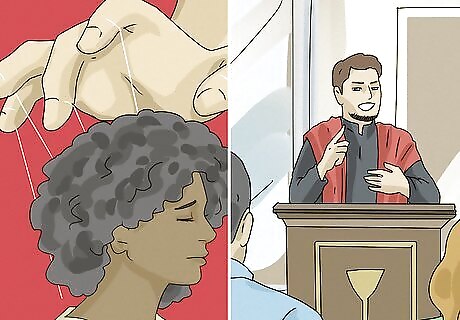
views

Learn the organization's foundations. Cults tend to have very simple and similar foundations and common factors having all or some of the following: A charismatic founder, leader or leadership. Have a structured central bureaucracy. Simplified goal or aim structure, such as to save something or introduce something to everyone. A society history, most new initiates are invariably required to learn and respect the founding figures. There is a degree of intellectual limitation, so outside ideas or interaction with non members are not encouraged There is also a system of repercussions, such as shunning, "time out" or isolating or demotion. There is a system of development, so a person may be groomed or encouraged to go towards certain roles, or assist in various ways. There is a tithe, membership dues or other system of getting money from members, rather than earning it externally.

Decide if there is an element of exploitation either financial or personal. This ultimately is where groups cross the line into a dangerous organization.

Look for the key danger signals for medium level risks: It may be OK to have some association with them, but stay on guard. Members are encouraged to do certain practices, methods and techniques and only those. There is no exploration, modification or comparison with other similar or different systems. The screening of new potential members is quite large as they filter looking for suitable like minded, or easily mold-able people. The society can accept and wear the money costs involved in having a very high grassroots turnover to get a few potentially ultra-loyal members, like-minded or easily manipulated members. There is a noticeable degree of repetition, so key figures such as the founder and their stories are often repeated to train people to think the same way. There is a medium degree of personal image inflation to make certain figures appear greater than they really were and that association with them is a great or noble thing. Members are all very similar and have minimal contact with the outside world, or the real world. There is a substantial amount of time, money, thought and encouragement invested in promotion, lobbying and marketing. Tax free status a major aspiration, or have already attained that. Funds or proceeds do not stay in the country or state they were earned in.

Investigate further. Such groups may still not be a danger to society, either in design or effect, but could one day be run by someone who will take it that direction very easily.

Look for high risk signs: These are usually signs that it has crossed the line into a dangerous or potentially dangerous organization. Manipulation of initiates is obvious to outsiders. It is very difficult, if not impossible to leave their society. The aim is to make the new person addicted to or so familiar with the cult that the person loses the ability to be independent, or their fears of repercussions are too high. That members are required to part with large amount of funds or assets. There is a high degree of mental stagnation, so that there is a focusing on key principles or myths and general day to day knowledge is encouraged to be forgotten. There is a degree of mentally stressful or intensive practices. These maybe long meditation retreats with little sleep or food, high intensive workouts or other things. They may be branded with an element of mystique and privilege. The person at the top of the organization has a kind of absolute ruling authority, which is rarely a healthy way to run an organization. So the founder may be a dubbed an avatar, master, guru, Bodhisattva, genius or other highly attained person, but the initiate will never be on the same level, especially if some "powers" are not possible to develop ordinarily or even exist. Members may or may not ever be aware of this. Leaders and next generation leaders are planned with no involvement or selection from the existing members. There is an amount of secrecy surrounding the beliefs or inner workings of the organization as opposed to transparency. All actions committed by members are justified or will be praised. Martyrdom may be encouraged. There is a very effective propaganda system as well as intensive (but covert) political lobbying. There is not always a vast leadership structure, but there can be. The more manipulative cult leadership prefers a wide gap between their status and others so may practice a more flat working hierarchy. This can create "succession" issues, but usually its known who the next in charge will be in advance. There is a top-down structure where the people on the bottom aren't allowed to question or challenge anyone above them. There is a definite separation from society.

If you see these signs, it is best to do one or all of the following. Learn your rights. If you are not prepared to leave the town, stay calm and simply don't get involved or take risks. Keep a polite distance so you are not made into an "enemy" of their group, which can be potentially dangerous in tight knit communities or remote towns. They won't harm you until you are a threat to them. Keep your thoughts and feelings to only those you trust. Encourage dialogue and exchanges between other groups. This prevents minorities or dissenters being silenced and the cult taking over the town. This does have confrontation risks if that was the plan all along, however. Move if it becomes intolerable or unsafe. No one is keeping you there but yourself. Notify a law enforcement agency if there is a clear sign of the law being broken. Legally they need a "smoking gun" to act on.

Think about how common this is. You might notice that most political parties, social clubs, sporting and health clubs, credit and banking systems, most religions and nationalities actually have these features and these are not what would be classified as dangerous. Most political parties have founding members, political history, ideology and identity and discourages interaction with "non members" or those with a different ways of looking at things. In effect there is an entrenched discouragement to change ideas, while having a trained loyalty system. There is also a degree of reverence for political leaders in the past, only if they were of that particular party, but members who cross the floor are deemed traitors.

Avoid becoming paranoid. Because the system used is so mainstream, you probably will be seeing it everywhere but that does not make every society or group dangerous. It just gives them the potential to be one.

















Comments
0 comment